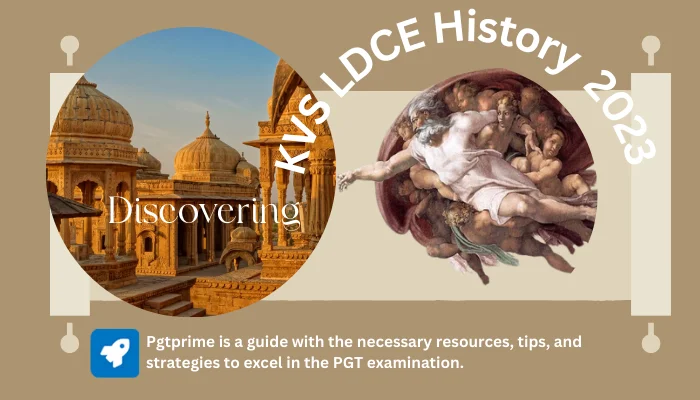👉FROM (Q.61-To-Q.80)
61. Consider the following statements about Amir Khusrau :
- He was the disciple of the sufi saint Shaikh Nizamuddin Auliya
- He is said to have written several treatise on music
- His work Khazain-ul Futuh deals with the reign of Sultan Kaiquabad
- The musical instrument sitar is regarded as his invention
Code : KVS LDCE History Question Paper and Answers PDF 2023
- (i) and (iv)
- (i), (ii), and (iii)
- (i), (ii), and (iv)
- (i), (iii, and (iv)
Answer: KVS LDCE History Question Paper and Answers PDF 2023
(3) (i), (ii), and (iv)
- He was the disciple of the sufi saint Shaikh Nizamuddin Auliya. This statement is true. Amir Khusrau was a disciple and close companion of the renowned sufi saint Shaikh Nizamuddin Auliya.
- He is said to have written several treatises on music. This statement is true. Amir Khusrau was not only a poet but also a highly skilled musician and composer. He is credited with writing several treatises on music, including the famous “Kitab al-Nawadir” and “Kitab al-Aqwal al-Khusrawiyya,” which delve into various aspects of music theory and practice.
- His work Khazain-ul Futuh deals with the reign of Sultan Kaiqubad. This statement is incorrect. “Khazain-ul Futuh” is not a work by Amir Khusrau but rather a historical chronicle written by Amir Hasan Sijzi, who served as a court historian during the reign of Sultan Alauddin Khalji. It provides a detailed account of the military campaigns and victories during Sultan Alauddin Khalji’s rule.
- The musical instrument sitar is regarded as his invention. This statement is not entirely accurate. While Amir Khusrau is often credited with the development and refinement of various musical instruments, including the sitar, it is more accurate to say that he played a significant role in the evolution and popularization of the sitar and other instruments rather than being their sole inventor
62. Which one of the following statements is not correct regarding Alauddin Khalji ?
- He established four separate markets in Delhi
- He introduced the system of dagh (branding of horses) and prepared huliya (descriptive list of soldiers)
- He maintained a large permanent standing army and paid them in cash
- He appointed a high officer called sahab-i Riyasat to control each market
Answer: KVS LDCE History Question Paper and Answers PDF 2023
(4) He appointed a high officer called sahab-i Riyasat to control each market is wrong
During Alauddin Khalji’s reign to refer to the officers in charge of controlling markets was “Diwan-i-Riyasat” and not “Sahab-i-Riyasat.” The Diwan-i-Riyasat was responsible for overseeing and regulating the markets and ensuring proper administration of economic affairs.
63. Mongol troops were divided into specific Units. Match List – I (Mongal army Units) with List – II (the number of soldiers maintained per Unit) :
| List – I | List – II |
| (a) Arban | (i) 100 |
| (b) Jagun | (ii) 1000 |
| (c) Mirghan | (iii) 10 |
| (d) Tuman | (iv) 10,000 |
Select the correct Answer from the code given below :
Code : KVS LDCE History Question Paper and Answers PDF 2023
| (a) | (b) | (c) | (d) | |
| (1) | (iii) | (i) | (ii) | (iv) |
| (2) | (i) | (ii) | (iii) | (iv) |
| (3) | (iv) | (iii) | (ii) | (i) |
| (4) | (ii) | (i) | (iv) | (iii) |
Answer: KVS LDCE History Question Paper and Answers PDF 2023
(1) (iii) (i) (ii) (iv)
The word “Arban” is Mongolian for “ten”. It was the name of the smallest unit in the Mongol army, which consisted of 10 soldiers. It was the basic unit of combat, and it was responsible for carrying out a variety of tasks, including scouting, raiding, and fighting.
The word “Jagun” is Mongolian for “hundred”. It was the name of a military unit in the Mongol army that consisted of 100 soldiers. Jaguns were also used to form larger formations, such as mingghans (regiments) and tumens (divisions).
The word “Mingghan” is Mongolian for “1000”. It was the name of a military unit in the Mongol army that consisted of 1000 soldiers. Ten jaguns (companies of 100 soldiers) made up a mingghan. Mingghans were commanded by a mingghan noyan, who was responsible for the unit’s discipline, morale, and training.
The word “Tumen” is Mongolian for “ten thousand”. It was the name of a military unit in the Mongol army that consisted of 10,000 soldiers. Ten mingghans (regiments of 1000 soldiers) made up a tumen. Tumens were commanded by a tumen noyan, who was responsible for the unit’s discipline, morale, and training.
64. Arrange the following monuments in chronological order of constructon and select the correct Answer from the code given below :
- Jama Masjid, Delhi
- Humayun’s Tomb, Delhi
- Badshahi Masjid, Lahore
- Taj Mahal, Agra.
Codes : KVS LDCE History Question Paper and Answers PDF 2023
| (a) | (b) | (c) | (d) | |
| (1) | (i) | (ii) | (iii) | (iv) |
| (2) | (ii) | (iv) | (i) | (iii) |
| (3) | (iii) | (i) | (ii) | (iv) |
| (4) | (iv) | (iii) | (ii) | (i) |
Answer: KVS LDCE History Question Paper and Answers PDF 2023
(2) (ii) (iv) (i) (iii)
- Humayun’s Tomb, Delhi: The construction of Humayun’s Tomb began in 1565 and was completed in 1572. It was commissioned by Emperor Humayun’s wife, Empress Bega Begum, and is considered a masterpiece of Mughal architecture.
- Taj Mahal, Agra: The construction of the Taj Mahal began in 1632 and was completed in 1653. It was commissioned by Emperor Shah Jahan as a mausoleum for his beloved wife, Mumtaz Mahal. The Taj Mahal is considered one of the most magnificent examples of Mughal architecture and is a UNESCO World Heritage Site.
- Jama Masjid, Delhi: The construction of Jama Masjid in Delhi started in 1650 and was completed in 1656. It was commissioned by Emperor Shah Jahan, who also built the iconic Taj Mahal. Jama Masjid is one of the largest and most renowned mosques in India.
- Badshahi Masjid, Lahore: The construction of Badshahi Masjid in Lahore, present-day Pakistan, started in 1671 and was completed in 1673. It was commissioned by Emperor Aurangzeb, the son of Shah Jahan. The Badshahi Masjid is one of the largest mosques in the world and is a prominent landmark of Lahore.
65. Consider the following names of the Mughal emperors of the eighteenth century. Which among the following sequence represent the correct chronological order ?
- Alamgir II
- Ahmad Shah
- Jahandar Shah
- Muhammad Shah
Select the correct Answer from the code given below : KVS LDCE History Question Paper and Answers PDF 2023
Code : KVS LDCE History Question Paper and Answers PDF 2023
- (ii), (i), (iii), (iv)
- (i), (ii), (iii), (iv)
- (iii), (iv), (ii), (i)
- (iii), (iv), (i), (ii)
Answer: KVS LDCE History Question Paper and Answers PDF 2023
(3) (iii), (iv), (ii), (i)
Jahandar Shah: Jahandar Shah became the Mughal emperor in 1717 after overthrowing his father, Bahadur Shah I. However, his reign was short-lived and marked by incompetence and mismanagement.
Muhammad Shah: Muhammad Shah ascended the throne in 1719 after the overthrow of Farrukhsiyar. He is known for his patronage of arts and culture, but his reign witnessed a decline in Mughal power and authority.
Ahmad Shah: Ahmad Shah became the Mughal emperor in 1748. His reign was marked by conflicts and struggles for power among the nobles, and the Mughal Empire continued to weaken during his rule.
Alamgir II: Mirza Aziz-ud-Din Muhammad, better known by his regnal name Alamgir II, was the fifteenth Mughal emperor from 1754 to 1759. He was the son of Jahandar Shah.
66. Which one of the following grandsons of Chenghiz Khan devastated Russian lands upto Moscow?
- Kublai Khan
- Hulagu Khan
- Batn Khan
- Mongke Khan
Answer: KVS LDCE History Question Paper and Answers PDF 2023
(3) Batn Khan
Batu Khan, the grandson of Genghis Khan, led the Mongol invasions into the Russian lands in the 13th century. He established the Golden Horde, a Mongol state in the region, and his forces devastated Russian lands, advancing as far as Moscow.
Kublai Khan was another grandson of Genghis Khan who founded the Yuan Dynasty in China.
Hulagu Khan was a grandson of Genghis Khan who led the Mongol conquest of the Abbasid Caliphate and established the Ilkhanate in Persia.
Mongke Khan was the fourth Great Khan of the Mongol Empire and played a significant role in expanding Mongol territories.
67. Which of the following is the correct chronological order of the Vijaynagara ruling dynastis.
- Saluva, Tuluva, Sangama, Aravidu
- Sangama, Saluva, Tuluva, Aravidu
- Sangama, Tuluva, Saluva, Aravidu
- Sangama, Aravidu, Saluva, Tuluva
Answer:
(2) Sangama, Saluva, Tuluva, Aravidu
The Sangama dynasty was the first ruling dynasty of the Vijayanagara Empire, established by Harihara I in 1336.
The Saluva dynasty succeeded the Sangama dynasty and ruled from 1485 to 1505.
The Tuluva dynasty followed the Saluva dynasty and ruled from 1505 to 1570.
Aravidu dynasty came into power and ruled from 1570 to 1646, marking the end of the Vijayanagara Empire.
68. Which of the followig state was one of the earliest to assert its independence from Delhi Sultante ?
- Jaunpur
- Gujrat
- Bengal
- Malwa
Answer: KVS LDCE History Question Paper and Answers PDF 2023
(1) Jaunpur
jaunpur, located in present-day Uttar Pradesh, was one of the earliest regions in India to assert its independence from the Delhi Sultanate. It became a prominent kingdom under the Sharqi dynasty, which ruled from the 14th to the 15th century. The rulers of Jaunpur maintained their autonomy and successfully resisted attempts by the Delhi Sultanate to regain control over the region.
69. Which ruler of the Vijaynagar dynasty had sent his embassy to the emperor of China?
- Saluva Narsimha
- Krishnadeva Raya
- Bukka I
- Harihar I
Answer: KVS LDCE History Question Paper and Answers PDF 2023
(3) Bukka I
Bukka I was one of the founders of the Vijayanagara Empire along with his brother, Harihara I. As part of diplomatic relations, Bukka I sent an embassy to the emperor of China to foster trade and cultural exchanges between the two regions.
70. Consider the following statements about the jiziya tax during the Mughl times and choose the correct anser from the code given below :
- Akbar abolished jiziya in 1564
- Akbar reimposed jiziya in 1575
- Akbar abolished the jiziya in 1579-1580
- Aurangzeb reimposed the jiziya in 1679
Code : KVS LDCE History Question Paper and Answers PDF 2023
- Only (i) and (ii)
- Only (i), (ii) and (iii)
- (i), (ii), (iii), (iv)
- Only (i) and (iv)
Answer: KVS LDCE History Question Paper and Answers PDF 2023
(3) (i), (ii), (iii), (iv)
Statement (i) is correct, as Akbar abolished the jiziya tax in 1564.
Statement (ii) is also correct, as Akbar did reimpose the jiziya tax in 1575, although it was later abolished again.
Statement (iii) is correct, as Akbar abolished the jiziya tax in 1579-1580, before it was reimposed by Aurangzeb.
Statement (iv) is correct, as Aurangzeb reimposed the jiziya tax in 1679.
71. Match the List I with List II and select the correct Answers from the code given below the lists.
| List I | List II |
| (Sufi Saints) | (Centre of their Activities) |
| (a) Shaikh Moinuddin Chishti | (i) Delhi |
| (b) Shaikh Bahauddin Zakariya | (ii) Ajodhan |
| (c) Shaikh Farid ud din Masud Ganj-i Shakar | (iii) Multan |
| (d) Shaikh Nizamuddin Aulyja | (iv) Ajmer |
Code: KVS LDCE History Question Paper and Answers PDF 2023
| (a) | (b) | (c) | (d) | |
| (1) | (iii) | (iv) | (ii) | (i) |
| (2) | (iii) | (ii) | (iv) | (i) |
| (3) | (iv) | (iii) | (ii) | (i) |
| (4) | (iv) | (ii) | (iii) | (i) |
Answer: KVS LDCE History Question Paper and Answers PDF 2023
(3) (iv) (iii) (ii) (i)
- Shaikh Moinuddin Chishti was associated with the city of Ajmer, where he established the famous Ajmer Sharif Dargah.
- Shaikh Bahauddin Zakariya was centered in the city of Multan in present-day Pakistan, where he spread his teachings and established a Sufi order.
- Shaikh Farid ud din Masud Ganj-i Shakar, commonly known as Baba Farid, had his activities centered in Pakpattan, a city in Punjab, Pakistan.
- Nizamuddin Aulya was a prominent Sufi saint associated with Delhi, where he attracted a large following and established his Khanqah.
72. Match List I with List II and select the correct Answer from the code given below the lists.
| List I | List II |
| (Sufi Saints) | (Meaning) |
| (a) Futuh | (i) Sufi hospice |
| (b) Khanqah | (ii) Conversations of a sufi saint |
| (c) Barkat | (iii) Unasked for charity |
| (d) Malfuz | (iv) Spiritual grace acquired by a sufi |
Code: KVS LDCE History Question Paper and Answers PDF 2023
| (a) | (b) | (c) | (d) | |
| (1) | (i) | (iii) | (ii) | (iv) |
| (2) | (iii) | (i) | (iv) | (ii) |
| (3) | (iii) | (ii) | (i) | (iv) |
| (4) | (iv) | (iii) | (ii) | (i) |
Answer: KVS LDCE History Question Paper and Answers PDF 2023
(2) (iii) (i) (iv) (ii)
- Futuh refers to unasked for charity or blessings that are bestowed upon individuals by Sufi saints without them having to request for it.
- Khanqah is a place where Sufi saints reside and carry out their spiritual activities. It is often referred to as a Sufi hospice or a center for spiritual gatherings and practices.
- Barkat signifies the spiritual grace or blessings that a Sufi saint acquires through their spiritual journey and practices. It represents the divine blessings and favors bestowed upon them.
- Malfuz refers to the recorded or written conversations, teachings, and discourses of a Sufi saint. It includes their spiritual insights, guidance, and wisdom shared with their disciples and followers.
73. Consider the following statements :
- Henri Pirenne was a Belgian historian
- He argued the impact of islamic expansion on the development of feudalism in Europe
- He stated that it were the Germanic invasions that destroyed the Mediterrarean unity
Choose the correct Answer from the code given below :
Code : KVS LDCE History Question Paper and Answers PDF 2023
- (i) only
- (ii) only
- (i) and (ii)
- (i) and (iii)
Answer: KVS LDCE History Question Paper and Answers PDF 2023
(3) (i) and (ii)
Henri Pirenne’s work focused on examining the influence of Islamic expansion and trade disruptions on the transformation of economic and social structures in Europe, including the development of feudalism.
74. Who propounded the theory of ‘feudalism as ties of dependence ‘?
- F.L. Genshof
- F.M. Stenton
- Marc Bloch
- Guy Bois
Answer: KVS LDCE History Question Paper and Answers PDF 2023
(3) Marc Bloch
Marc Bloch, a prominent French historian and medievalist, propounded the theory of “feudalism as ties of dependence. According to Bloch, feudalism was not simply a political and economic system based on land ownership and obligations, but rather a complex web of personal relationships and dependencies.
75. Which one of the following pairs regarding Roman Cultural activity is not correctly paired ?
| (1) Cicero Works | – | on oratory and philolosphy |
| (2) Cornelius Nepos | – | Composed Latin Biography |
| (3) Vergil | – | Wrote Rome’s national Epic, the Aeneid |
| (4) Horace | – | Wrote masterly commentaries on Gallic and Civil Wars |
Answer: KVS LDCE History Question Paper and Answers PDF 2023
(4) Horace – Wrote masterly commentaries on Gallic and Civil Wars
- Cicero, the Roman statesman, lawyer, and philosopher, is known for his extensive works on oratory and philosophy. He was considered one of the greatest orators of his time and played a significant role in Roman politics.
- Cornelius Nepos was a Roman historian and biographer who is known for his work in composing Latin biographies. He wrote a collection of biographies titled “De Vita Excellentium Imperatorum” (On the Lives of Famous Commanders), which included biographical accounts of prominent Greek and Roman leaders.
- Vergil, also known as Virgil, was a Roman poet who is famous for his epic poem called the “Aeneid.” The Aeneid is considered Rome’s national epic as it tells the legendary story of Aeneas, a Trojan hero who traveled to Italy and became the ancestor of the Roman people.
- Horace, the Roman poet and satirist, did not write masterly commentaries on Gallic and Civil Wars. This statement is incorrect. Horace is known for his lyric poetry and satires, not for commentaries on wars.
76. As trade expanded in the thirteenth and fourteenth centuries, ships carrying goods from distant countries started arriving in European ports. Along with ships came rats carrying the deadly bubonic plague infection (the Black Death). The time estimate of this epidemic was :
- 1325 – 1330
- 1342 – 1345
- 1345 – 1348
- 1347 – 1350
Answer: KVS LDCE History Question Paper and Answers PDF 2023
(4) 1347 – 1350
The time estimate of the Black Death epidemic, caused by the bubonic plague, is commonly considered to be from 1347 to 1350. The outbreak started in Europe during the mid-14th century and spread rapidly, resulting in one of the most devastating pandemics in history.
77. The first Jesuit mission reached Akbar’s court at Fatehpur Sikri in :
- 1570
- 1575
- 1580
- 1589
Answer: KVS LDCE History Question Paper and Answers PDF 2023
(3) 1580
The first Jesuit mission reached Akbar’s court at Fatehpur Sikri in 1580. They were known for their missionary work and played a significant role in spreading Christianity during the age of exploration and colonization.
Akbar, the Mughal emperor, was known for his religious tolerance and interest in various faiths. He established a policy of Sulh-e-Kul, which promoted harmony among different religions.
78. Which Assyrian king transformed Nineveh, on the east bank of Tigris, into a city of unparalleled splendor?
- Shamshi-Adad V
- Sennacherib
- Esarhaddon
- Nabopolassar
Answer: KVS LDCE History Question Paper and Answers PDF 2023
(2) Sennacherib
Sennacherib was one of the most powerful and influential kings of the Neo-Assyrian Empire, ruling from 705 to 681 BC. Under his reign, Nineveh, located on the east bank of the Tigris River in present-day Iraq, became the capital city and a center of magnificent architecture, infrastructure, and cultural achievements.
79. Under which Byzantine Emperor the compilation of Roman law was enacted between 527 C to 534 C?
- Romulus
- Justinian I
- Augustus
- Gaius Marius
Answer: KVS LDCE History Question Paper and Answers PDF 2023
(2) Justinian I
The compilation of Roman law under Justinian I aimed to create a standardized and comprehensive legal system, providing a basis for legal practice and administration throughout the Byzantine Empire.
While Romulus was the legendary founder and first king of Rome, Augustus was the first Roman Emperor, and Gaius Marius was a prominent military and political figure in the late Roman Republic. However, it was Justinian I who oversaw the enactment of the compilation of Roman law.
80. Mahmud Ghazni gathered around him a group of poets who composed anthologies. Among them the most outstanding poet was?
- Al-Beruni
- Firdausi
- Jahiz
- Tabari
Answer: KVS LDCE History Question Paper and Answers PDF 2023
(2) Firdausi
Among the poets gathered by Mahmud Ghazni, the most outstanding poet was Firdausi. Firdausi, also known as Abu’l-Qasim Ferdowsi, was a Persian poet who lived during the 10th and 11th centuries. He is best known for his epic poem, the Shahnameh (Book of Kings), which chronicles the mythical and historical past of Persia (Iran) from the creation of the world until the Islamic conquests.











